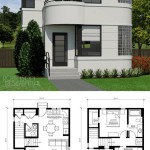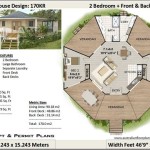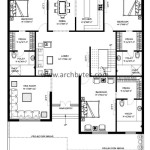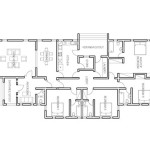Simple Modern Farmhouse Open Floor Plans: A Guide to Spacious and Stylish Living
The simple modern farmhouse aesthetic has gained immense popularity in recent years, celebrated for its blend of rustic charm and contemporary functionality. A key element of this style is the open floor plan, which combines living, dining, and kitchen areas into a single, unified space. This design facilitates a sense of connection, allows for greater flexibility, and enhances natural light throughout the home. Understanding the principles and considerations behind creating a successful simple modern farmhouse open floor plan is crucial for achieving a comfortable and aesthetically pleasing living environment.
Designing an open floor plan requires careful planning and consideration of various factors, including space allocation, traffic flow, and visual cohesion. The overall goal is to create a space that feels both spacious and inviting, while maintaining a sense of order and functionality. The integration of modern elements with farmhouse-inspired details is essential for achieving the desired aesthetic. This involves selecting appropriate materials, finishes, and furnishings that complement the architectural design and create a harmonious atmosphere.
Modern farmhouse style often incorporates natural materials such as wood, shiplap, and stone, alongside clean lines and minimalist decor. The open floor plan allows these elements to be showcased effectively, creating a sense of warmth and authenticity. The use of neutral color palettes, combined with pops of color through accessories and artwork, adds visual interest without overwhelming the space. Ultimately, a successful simple modern farmhouse open floor plan blends practicality with aesthetic appeal, creating a space that is both comfortable and stylish.
Key Point 1: Defining Zones in an Open Floor Plan
One of the primary challenges in designing an open floor plan is defining distinct zones for different activities without using traditional walls. This can be achieved through various architectural and design strategies that create visual and functional separation. Understanding these zoning techniques is essential for creating a cohesive and well-organized living space.
Furniture Arrangement: Strategic furniture placement is a highly effective way to define zones within an open floor plan. A large sectional sofa can delineate the living area from the dining space, while a kitchen island serves as a natural boundary between the kitchen and living areas. Placing furniture in a way that creates pathways and defines specific areas helps to guide traffic flow and create a sense of order. For example, a console table behind a sofa can act as a divider, providing a visual barrier without completely obstructing the view. Rugs can also be used to anchor furniture groupings and visually define separate zones within the larger space. A large area rug beneath the dining table creates a clear distinction from the surrounding areas.
Changes in Flooring: Varying flooring materials can create subtle but effective visual separation. Transitioning from hardwood in the living area to tile in the kitchen visually defines the two spaces. Similarly, incorporating a different type of wood flooring or changing the direction of the planks can subtly delineate zones within the open floor plan. The use of area rugs, as mentioned earlier, is another way to achieve this effect. Strategically placed rugs not only add warmth and texture but also help to define seating areas and other zones.
Architectural Elements: Incorporating architectural elements like columns, partial walls, or built-in shelving units can define zones without completely closing off the space. These elements provide a visual barrier while still allowing light and air to flow freely. A half wall, for instance, can separate the kitchen from the dining area while maintaining an open feel. Similarly, a strategically placed column can visually define a transition point between different zones. Built-in bookshelves can serve as both a functional storage solution and a visual divider, creating a sense of separation while maintaining the open feel of the floor plan.
Lighting: Lighting can play a crucial role in defining zones within an open floor plan. Different types of lighting can be used to create distinct atmospheres in different areas. For example, pendant lights above a kitchen island can define the cooking zone, while recessed lighting in the living area creates a more relaxed ambiance. Layering lighting, with a combination of ambient, task, and accent lighting, enhances the functionality and aesthetic appeal of each zone. Dimmer switches allow for adjusting the lighting levels to create the desired mood in each area.
Color and Texture: Using different colors and textures can subtly differentiate zones within an open floor plan. A different wall color in the dining area can create a visual distinction from the living area. Similarly, incorporating textured wallpaper or different fabrics can add visual interest and define specific zones. The use of contrasting colors and textures can enhance the overall design and create a more dynamic and engaging space. Careful consideration of color palettes and material choices is essential for achieving a cohesive and harmonious look.
Key Point 2: Integrating Modern and Farmhouse Elements
Achieving the simple modern farmhouse aesthetic requires a thoughtful blend of contemporary and rustic elements. The key is to create a balance that feels both fresh and timeless. Understanding the core principles of both styles and how they can be integrated seamlessly is crucial for success.
Neutral Color Palette: A neutral color palette is a cornerstone of the modern farmhouse style. Whites, creams, grays, and light beiges provide a clean and timeless backdrop that allows the architectural details and furnishings to stand out. Using a consistent color palette throughout the open floor plan creates a sense of cohesion and unity. Pops of color can be introduced through accessories, artwork, and textiles, adding visual interest without disrupting the overall harmony of the space. For example, incorporating a blue or green accent wall or adding colorful cushions and throws can brighten up the space and add personality.
Natural Materials: Incorporating natural materials is essential for achieving the farmhouse aesthetic. Wood, stone, and metal add warmth, texture, and authenticity to the space. Reclaimed wood beams, shiplap walls, and stone fireplaces are classic farmhouse elements that can be integrated into the open floor plan. These materials add character and create a sense of history and connection to nature. Integrating these elements strategically enhances the overall aesthetic and creates a warm and inviting atmosphere. Using natural materials also contributes to the durability and longevity of the design.
Clean Lines and Minimalist Decor: Balancing the rustic elements with clean lines and minimalist decor is crucial for achieving the modern farmhouse aesthetic. Avoid clutter and opt for simple, functional furnishings that complement the architectural design. Clean-lined sofas, minimalist coffee tables, and streamlined kitchen cabinets create a sense of order and modernity. This approach helps to prevent the space from feeling too cluttered or overly traditional. The focus should be on creating a comfortable and functional living environment that is both stylish and practical.
Modern Lighting Fixtures: Incorporating modern lighting fixtures can add a contemporary touch to the farmhouse style. Sleek pendant lights, recessed lighting, and minimalist sconces provide functional illumination while enhancing the overall aesthetic. Mixing metal finishes, such as black iron or brushed nickel, with natural materials creates a balanced and sophisticated look. The lighting should be both functional and aesthetically pleasing, contributing to the overall ambiance of the open floor plan. Consider using dimmer switches to adjust the lighting levels and create different moods in various zones.
Farmhouse Accents: Adding farmhouse accents, such as antique furniture, vintage accessories, and handmade textiles, can enhance the overall charm of the open floor plan. These elements add character and create a sense of history and authenticity. For example, incorporating a vintage farmhouse table in the dining area or displaying antique decor on shelves can add personality and charm. However, it's important to avoid overcrowding the space with too many accents. The key is to select a few carefully chosen pieces that complement the overall design and enhance the farmhouse aesthetic.
Key Point 3: Maximizing Natural Light and Ventilation
Natural light and ventilation are crucial for creating a comfortable and inviting open floor plan. Maximizing these elements enhances the overall ambiance of the space and contributes to a healthy and sustainable living environment. Careful planning and consideration of window placement, orientation, and ventilation strategies are essential.
Window Placement and Size: Strategically placing windows to maximize natural light is essential. Large windows, strategically placed, can flood the open floor plan with sunlight, creating a bright and airy atmosphere and reduce the need for artificial lighting. Consider the orientation of the house and position windows to capture the most sunlight throughout the day. For example, south-facing windows receive the most sunlight in the northern hemisphere, while north-facing windows provide consistent, indirect light. Incorporating skylights or clerestory windows can also bring natural light into areas that might otherwise be dark. Window size should be proportional to the room size and the overall design aesthetic.
Window Treatments: Selecting appropriate window treatments is crucial for controlling natural light and maintaining privacy. Sheer curtains or blinds can filter the light while still allowing it to enter the space. Blackout curtains can be used in bedrooms or media rooms to block out light when needed. The choice of window treatments should complement the overall design aesthetic and enhance the functionality of the space. Consider using automated blinds or shades for added convenience and energy efficiency.
Ventilation Strategies: Proper ventilation is essential for maintaining a comfortable and healthy indoor environment. Cross-ventilation, achieved by placing windows on opposing walls, allows for natural airflow and helps to regulate temperature. Ceiling fans can also improve air circulation and reduce the need for air conditioning. Consider incorporating operable skylights or transom windows to promote natural ventilation. Proper ventilation helps to remove stale air, reduce humidity, and improve indoor air quality.
Light-Reflecting Surfaces: Using light-reflecting surfaces can help to maximize the amount of natural light in the open floor plan. Light-colored walls, ceilings, and flooring reflect light and make the space feel brighter and more spacious. Glossy finishes on furniture and accessories can also help to reflect light and enhance the overall ambiance. Mirrors, strategically placed, can amplify natural light and create the illusion of more space. Consider using light-colored textiles and fabrics to further enhance the light-reflecting properties of the space.
Landscaping Considerations: Landscaping can play a crucial role in maximizing natural light and ventilation. Planting trees and shrubs strategically can provide shade in the summer and allow sunlight to enter in the winter. Consider the placement of trees and shrubs in relation to windows to optimize natural light and ventilation. Proper landscaping can also help to improve the overall aesthetic appeal of the property and create a more harmonious connection between the interior and exterior spaces. Ensure that landscaping elements do not obstruct windows or block natural light.

Small Farmhouse Plans Fit For Fall Blog Eplans Com

10 Amazing Modern Farmhouse Floor Plans Rooms For Blog

Economical Contemporary Modern House Plan With Open Floor Layout 7819

Everyone Loves Modern Farmhouse Plans But Why Houseplans Blog Com

Best Modern Farmhouse Decor Ideas For Every Room Of The House Decorilla Interior Design

House Floor Plans Your Best Guide To Home Layout Ideas Decorilla Interior Design

10 Small House Plans With Open Floor Blog Homeplans Com

Open Floor Plans Build A Home With Smart Layout Blog Dreamhomesource Com
Modern Farmhouse Plan Free 10 Best Floor Plans Farm Style House Blueprints Civiconcepts

New Home Construction Trends Why The Open Concept Floor Plan Works Generation Homes Northwest
Related Posts








